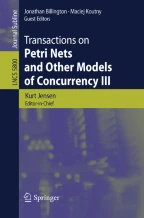Part of the book series:Lecture Notes in Computer Science ((TOPNOC,volume 5800))
604Accesses
Abstract
In this paper we present two new algorithms that effectively synthesize a finite place/transition Petri net (p/t-net) from a finite set of labeled partial orders (a finite partial language). Either the synthesized p/t-net has exactly the non-sequential behavior specified by the partial language, or there is no such p/t-net. The first algorithm is an improved version of a synthesis algorithm presented in [14], which uses the classical theory of regions applied to the set of step sequences generated by the given partial language. Instead of computing all step sequences, the new algorithm directly works on appropriate prefixes specified in the partial language. The second algorithm is based on the theory of token flow regions for partial languages developed in [16,15,14]. While in [15,14] a so called basis representation is applied, the new algorithm combines the concepts of separation representation and token flows. We implemented both synthesis algorithms in our framework VipTool. A comparison of the two new algorithms with the two predecessor algorithms presented in [14,15]shows that both perform better than their respective predecessor. Therefore, a detailed comparison of these two synthesis algorithms is presented.
This is a preview of subscription content,log in via an institution to check access.
Preview
Unable to display preview. Download preview PDF.
Similar content being viewed by others
References
Badouel, E., Darondeau, P.: On the Synthesis of General Petri Nets. Technical Report 3025, Inria (1996)
Bergenthum, R., Desel, J., Lorenz, R., Mauser, S.: Synthesis of Petri Nets from Infinite Partial Languages. In: ACSD 2008, pp. 170–179. IEEE, Los Alamitos (2008)
Bergenthum, R., Desel, J., Lorenz, R., Mauser, S.: VipTool-Homepage (2009),http://viptool.ku-eichstaett.de
Cortadella, J., Kishinevsky, M., Kondratyev, A., Lavagno, L., Yakovlev, A.: Petrify: A Tool for Manipulating Concurrent Specifications and Synthesis of Asynchronous Controllers. IEICE Trans. of Informations and Systems E80-D(3), 315–325 (1997)
Cortadella, J., Kishinevsky, M., Kondratyev, A., Lavagno, L., Yakovlev, A.: Hardware and Petri Nets: Application to Asynchronous Circuit Design. In: Nielsen, M., Simpson, D. (eds.) ICATPN 2000. LNCS, vol. 1825, pp. 1–15. Springer, Heidelberg (2000)
Darondeau, P.: Deriving Unbounded Petri Nets from Formal Languages. In: Sangiorgi, D., de Simone, R. (eds.) CONCUR 1998. LNCS, vol. 1466, pp. 533–548. Springer, Heidelberg (1998)
Ehrenfeucht, A., Rozenberg, G.: Partial (Set) 2-Structures. Part i: Basic Notions and the Representation Problem. Part ii: State Spaces of Concurrent Systems. Acta Inf. 27(4), 315–368 (1989)
Grabowski, J.: On Partial Languages. Fundamenta Informaticae 4(2), 428–498 (1981)
Heiner, M., Koch, I., Will, J.: Model Validation of Biological Pathways Using Petri Nets - Demonstrated for Apoptosis. Journal BioSystems 75(1-3), 15–28 (2004)
Hoogers, P., Kleijn, H., Thiagarajan, P.: A Trace Semantics for Petri Nets. Information and Computation 117(1), 98–114 (1995)
Josephs, M.B., Furey, D.P.: A Programming Approach to the Design of Asynchronous Logic Blocks. In: Cortadella, J., Yakovlev, A., Rozenberg, G. (eds.) Concurrency and Hardware Design. LNCS, vol. 2549, pp. 34–60. Springer, Heidelberg (2002)
Kiehn, A.: On the Interrelation Between Synchronized and Non-Synchronized Behaviour of Petri Nets. Elektronische Informationsverarbeitung und Kybernetik 24(1/2), 3–18 (1988)
Liang, H., Dingel, J., Diskin, Z.: A Comparative Survey of Scenario-Based to State-Based Model Synthesis Approaches. In: SCESM 2006, pp. 5–12. ACM, New York (2006)
Lorenz, R., Bergenthum, R., Desel, J., Mauser, S.: Synthesis of Petri Nets from Finite Partial Languages. Fundamenta Informaticae 88(4), 437–468 (2009)
Lorenz, R., Bergenthum, R., Mauser, S., Desel, J.: Synthesis of Petri Nets from Finite Partial Languages. In: ACSD, pp. 157–166. IEEE, Los Alamitos (2007)
Lorenz, R., Juhás, G.: Towards Synthesis of Petri Nets from Scenarios. In: Donatelli, S., Thiagarajan, P.S. (eds.) ICATPN 2006. LNCS, vol. 4024, pp. 302–321. Springer, Heidelberg (2006)
Lorenz, R., Juhás, G., Mauser, S.: How to Synthesize Nets from Languages - a Survey. In: WSC, pp. 637–647. IEEE, Los Alamitos (2007)
Pratt, V.: Modelling Concurrency with Partial Orders. Int. Journal of Parallel Programming 15, 33–71 (1986)
Schrijver, A.: Theory of Linear and Integer Programming. Wiley, Chichester (1986)
van der Aalst, W.M.P., van Dongen, B.F., Günther, C.W., Mans, R.S., de Medeiros, A.K.A., Rozinat, A., Rubin, V., Song, M., Verbeek, E., Weijters, A.J.M.M.: ProM 4.0: Comprehensive Support for Real Process Analysis. In: Kleijn, J., Yakovlev, A. (eds.) ICATPN 2007. LNCS, vol. 4546, pp. 484–494. Springer, Heidelberg (2007)
van der Aalst, W.M.P., Weijters, T., Maruster, L.: Workflow Mining: Discovering Process Models from Event Logs. IEEE Trans. Knowl. Data Eng. 16(9), 1128–1142 (2004)
Verbeek, E., van der Toorn, R.A.: Transit Case Study. In: Cortadella, J., Reisig, W. (eds.) ICATPN 2004. LNCS, vol. 3099, pp. 391–410. Springer, Heidelberg (2004)
Vogler, W.: Modular Construction and Partial Order Semantics of Petri Nets. LNCS, vol. 625. Springer, Heidelberg (1992)
Author information
Authors and Affiliations
Department of Applied Computer Science, Catholic University of Eichstätt-Ingolstadt,
Robin Bergenthum, Jörg Desel & Sebastian Mauser
- Robin Bergenthum
You can also search for this author inPubMed Google Scholar
- Jörg Desel
You can also search for this author inPubMed Google Scholar
- Sebastian Mauser
You can also search for this author inPubMed Google Scholar
Editor information
Editors and Affiliations
Faculty of Science, Department of Computer Science, University of Aarhus, IT-parken, Aabogade 34, 8200, Aarhus N, Denmark
Kurt Jensen
School of Electrical and Information Engineering, University of South Australia, Mawson Lakes Campus, 5095, Mawson Lakes, South Australia, Australia
Jonathan Billington
SCS, Newcastle University, NE1 7RU, Newcastle upon Tyne, UK
Maciej Koutny
Rights and permissions
Copyright information
© 2009 Springer-Verlag Berlin Heidelberg
About this chapter
Cite this chapter
Bergenthum, R., Desel, J., Mauser, S. (2009). Comparison of Different Algorithms to Synthesize a Petri Net from a Partial Language. In: Jensen, K., Billington, J., Koutny, M. (eds) Transactions on Petri Nets and Other Models of Concurrency III. Lecture Notes in Computer Science, vol 5800. Springer, Berlin, Heidelberg. https://doi.org/10.1007/978-3-642-04856-2_9
Download citation
Publisher Name:Springer, Berlin, Heidelberg
Print ISBN:978-3-642-04854-8
Online ISBN:978-3-642-04856-2
eBook Packages:Computer ScienceComputer Science (R0)
Share this chapter
Anyone you share the following link with will be able to read this content:
Sorry, a shareable link is not currently available for this article.
Provided by the Springer Nature SharedIt content-sharing initiative
